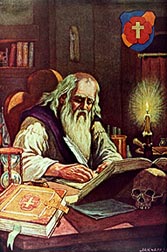Rosicrucianism
Rosicrucianism is a spiritual and cultural movement which arose in Europe in the early 17th century. The movement's manifesto was first published in 1614, with the release of the Fama Fraternitatis Rosae Crucis, followed by two other manifestos. Rosicrucianism is built on esoteric truths of the ancient past, which, concealed from the average man, provide insight into nature, the physical universe, and the spiritual realm. It has influenced the realms of philosophy, alchemy, science, and theology, intertwining with various aspects of Western esoteric tradition.
History[edit | edit source]
The origins of Rosicrucianism are subject to speculation. The movement announced itself to the world with the publication of the Fama Fraternitatis Rosae Crucis (The Fame of the Brotherhood of the Rosy Cross) in 1614. This was followed by the Confessio Fraternitatis (The Confession of the Brotherhood of the Rosy Cross) in 1615, and the Chymical Wedding of Christian Rosenkreutz in 1616. These manifestos proclaimed a "universal reformation of mankind", through a science allegedly kept secret for decades until the intellectual climate might receive it.
Beliefs and Practices[edit | edit source]
Rosicrucian beliefs and practices are a blend of mystical, philosophical, and religious elements. They emphasize the inner, spiritual development of the individual. This development is said to be attainable through the study of nature, the arts, alchemy, and the symbolic interpretation of the Bible. Rosicrucians claim to offer knowledge regarding the nature of the universe, the immortality of the soul, and the powers latent in humans.
Influence[edit | edit source]
The influence of Rosicrucianism has been significant in the development of Western esoteric traditions. Its symbols, such as the Rosy Cross, have been widely adopted by later esoteric movements. Rosicrucianism has also been linked to the development of modern Freemasonry, with some Masonic rites incorporating Rosicrucian symbols and ideas. Furthermore, its impact can be seen in the arts, literature, and some scientific disciplines, as it promoted a holistic view of the world that integrated science and spirituality.
Modern Rosicrucian Groups[edit | edit source]
Today, several organizations claim to be the heirs to the original Rosicrucian tradition. These include the Ancient Mystical Order Rosae Crucis (AMORC), the Rosicrucian Fellowship, and the Lectorium Rosicrucianum. Each of these groups offers teachings and practices they claim derive from the ancient Rosicrucian wisdom, adapted to contemporary spiritual needs.
Criticism and Controversy[edit | edit source]
Throughout its history, Rosicrucianism has faced criticism and skepticism. Critics argue that the historical evidence for the movement's early existence is thin, suggesting that the manifestos could be a hoax or satire. Despite these controversies, Rosicrucianism has endured as a significant and influential spiritual tradition.
Navigation: Wellness - Encyclopedia - Health topics - Disease Index - Drugs - World Directory - Gray's Anatomy - Keto diet - Recipes
Search WikiMD
Ad.Tired of being Overweight? Try W8MD's physician weight loss program.
Semaglutide (Ozempic / Wegovy and Tirzepatide (Mounjaro) available.
Advertise on WikiMD
WikiMD is not a substitute for professional medical advice. See full disclaimer.
Credits:Most images are courtesy of Wikimedia commons, and templates Wikipedia, licensed under CC BY SA or similar.
Contributors: Prab R. Tumpati, MD






